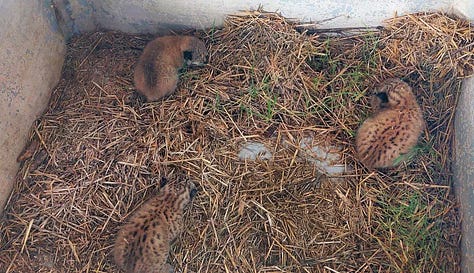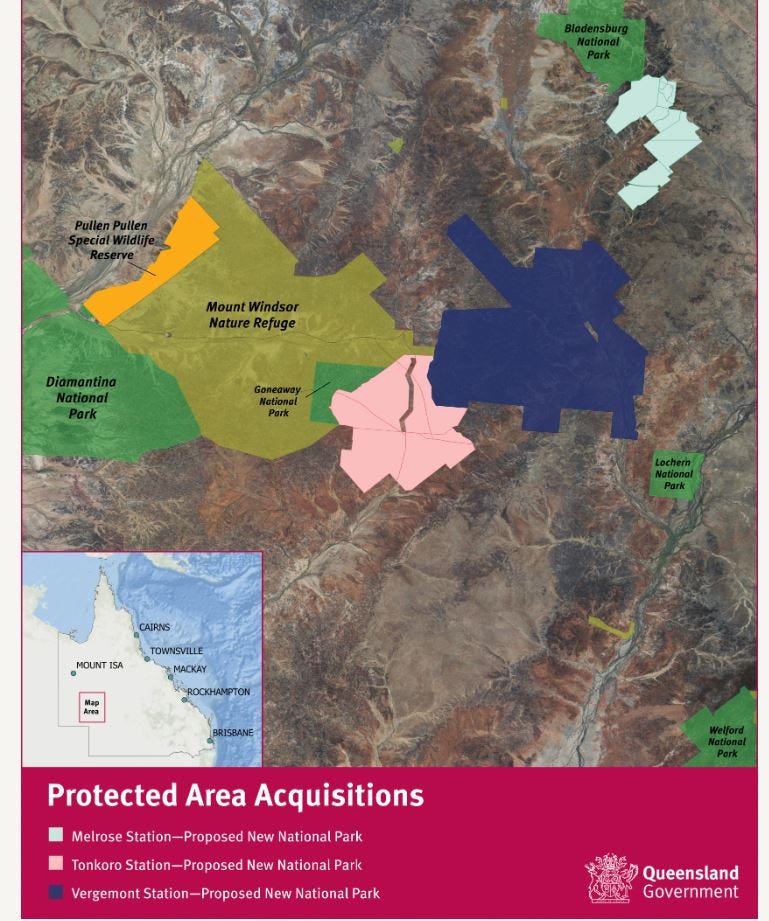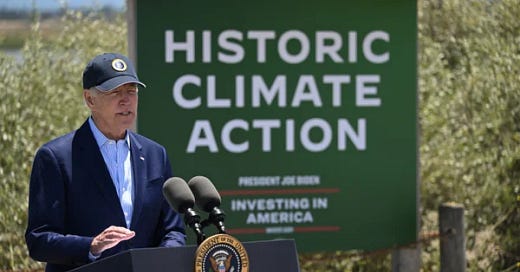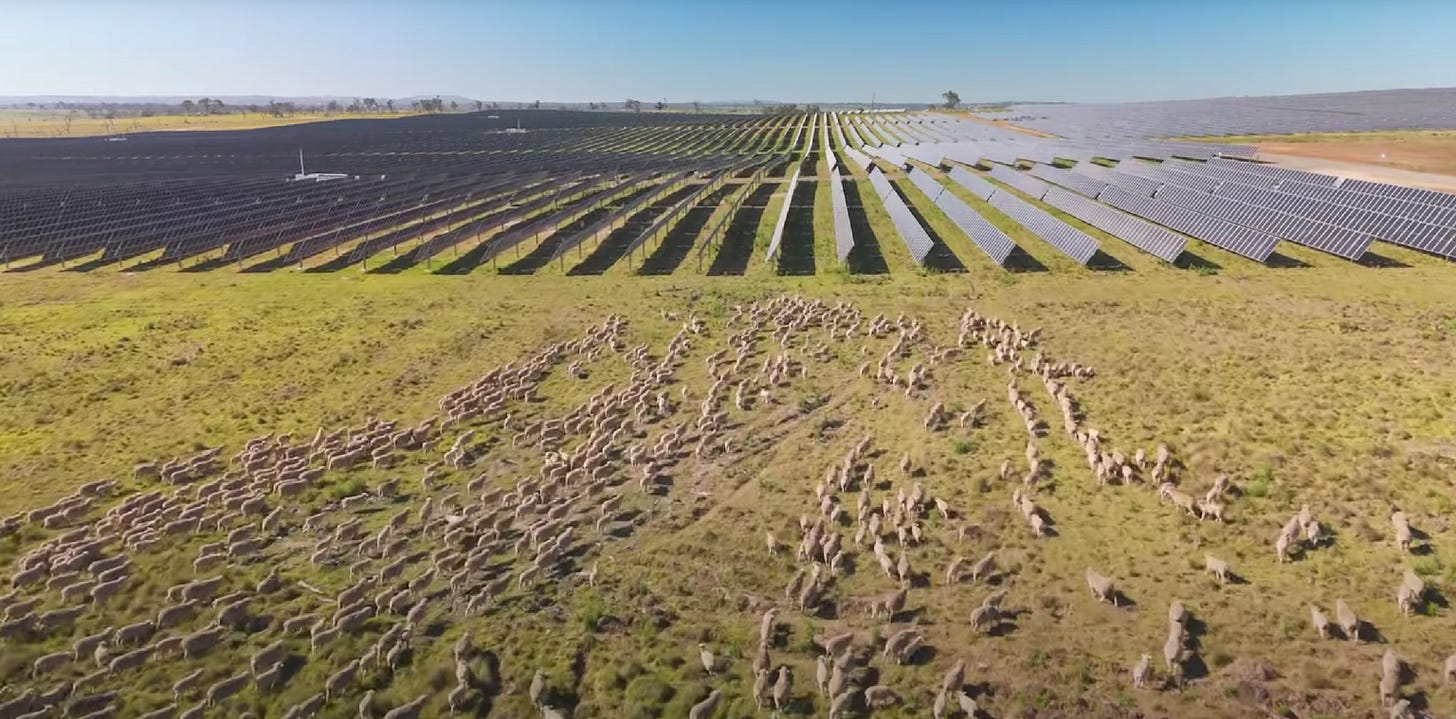The Weekly Anthropocene, May 1 2024
An epic wave of historic new U.S. climate actions from President Biden, Iberian lynx success, solar in Zambia, agrivoltaics in Australia, Mongolian gazelles, global EV sales keep booming, and more!
The Weekly Anthropocene is headed to India this May for a one-person on-the-ground independent environmental progress reporting trip! Regular weekly newsletters resume June 2024. Become a paid subscriber to support & follow my dispatches from India!
United States
The Biden Administration continues to absolutely “knock it out of the park” on climate progress, with a wave of new federal actions recently announced relating to new clean power transmission lines, billions in funding for grid upgrades and clean manufacturing projects, stricter anti-mercury pollution regulations, investments in decarbonizing the iron and steel industries, a much-needed action plan to speed up the permitting process and fast-track more clean energy development, and much more! Seriously, if you click one link today, check out just this one White House news release; the list of bold U.S. climate actions there would have been beyond the wildest dreams of an environmentalist in 2010, and now it barely makes the news!
But this is a particularly big one: for the first time since the Obama Administration’s Clean Power Plan (sadly canceled under Trump), the EPA is setting serious new Clean Air Act standards to reduce pollution from fossil fuel power plants. The new final rule mandates that all coal plants and all newly built baseload gas plants will need to control (i.e. not emit) 90% of their carbon pollution by 2032 (!!!!!), and must close by 2039 if they do not achieve these emissions reductions!
It’s hard to overstate how big a deal this could be; it’s really the capstone of President Biden’s epochal climate actions! If the Inflation Reduction Act’s massive federal tax credits for renewable energy are the “carrot,” these new EPA emissions reduction rules are the “stick.” If it holds up in court, this rule could close every single U.S. coal plant by the 2030s—and it’s already incredibly cheap and easy to replace them with clean, abundant renewables! (In theory coal plants could also keep running with carbon capture, but in practice power plant-scale carbon capture has has over and over again completely failed to work and renewables are much cheaper). And let’s not forget the immense local benefits from air pollution reduction as well, in addition to global climate benefits. The EPA estimates that in 2035 alone, the new rule will avoid 360,000 cases of asthma symptoms and prevent up to 1,200 premature deaths.
Absolutely SPECTACULAR news!
“This year, the United States is projected to build more new electric generation capacity than we have in two decades – and 96 percent of that will be clean.
President Biden’s leadership has not only sparked an unprecedented expansion in clean electricity generation, his leadership has also launched an American manufacturing renaissance. America is now a magnet for private investment, with hundreds of billions of dollars committed and 270,000 new clean energy jobs created.
This is how we win the future, by harnessing new technologies to grow our economy, deliver environmental justice, and save the planet for future generations.”
-Ali Zaidi, U.S. National Climate Advisor
Spain
The Iberian lynx (Lynx pardinus) was on the verge of extinction as recently as 2002, with only 94 individuals left. Years of captive breeding and community conservation work have paid off spectacularly; in 2022, the species’ population reached 1,668, and they’re expanding their wild range across Spain and Portugal.



In March 2024, a rancher in the Spanish village of Menasalbas unexpectedly found three newborn Iberian lynx cubs on a haystack in his barn. Hastily deployed camera traps soon revealed the mother coming back to feed them, and eventually she chose to move her family to an unknown new location. The mother was wild-born, not released from the captive breeding program, so she didn’t have a radio collar. (Pictured above, from El País). This delightful happenstance provides a brilliant example of what successful human-wildlife coexistence looks like; a species on the brink of extinction is now thriving in a supportive community landscape!
Barcelona is getting a new floating desalination plant, rated to produce 40,000 cubic meters of fresh water per day (about 6% of the metro area’s total consumption), to help ensure consist water supplies in the face of a years-long drought. 12 smaller floating desalination plants will also be deployed across the rest of coastal Catalonia. Floating desalination looks like a great modular easily-deployable climate resilience solution for thirsty coastal cities around the globe!
A prototype wave energy converter system has been approved for the deployment in the waters of Spain’s Basque Country. Fully submerged and with little to no impact on marine life, the CETO system generates electricity with a buoyant actuator. It’s completely modular and could eventually be arranged in large arrays, like solar panels. A potential new renewables mainstay in the making!
Well-established solar, wind, and batteries continue to boom across Spain as well; the nation recently announced a massive tender (i.e. an offer for companies to bid to build projects) for over 1.2 gigawatts (specifically, 1,259 MW) of new clean energy capacity!
Zambia
Canadian renewables developer SkyPower has signed a massive new power purchase agreement (PPA) with the government of Zambia, committing to build 1 gigawatt (1,000 MW) of new solar power capacity in the African nation. The project, dubbed Green Giant Zambia, will supply electricity to 4 million homes (less than 50% of Zambia’s population had access to electricity as of 2020, so this is a big deal!) and help provide electricity to enable further industrial development in Zambia. Notably, immense new copper deposits have been discovered in Zambia recently (with the help of AI, as it happens), contributing to a surge in mining investment. Copper demand is projected to grow substantially due to global electrification, so what we have here is renewables helping power a developing country bootstrapping their development with renewables-boosting commodity! Another hopeful step forward for solar-powered development in Africa. Great work!
“The Green Giant Zambia project is a crucial component of our Integrated Renewable Energy Plan, especially in the context of our current drought owing to climate change.
This initiative aims to substantially increase our renewable capacity to address both current and future energy needs as Zambia aims to increase industrial productivity and fulfill our aspiration to attain over 3 million metric tonnes of annual copper production.”
-Hakainde Hichilema, President of Zambia
Australia
The massive Vergemont Station in the Australian state of Queensland sits at the headwaters of the Lake Eyre Basin and is home to species ranging from the yellow-footed rock wallaby to the endangered night parrot. It stretches across 352,000 hectares (an area larger than Rhode Island), and it’s been up for sale since 2016.

Now, thanks to an anonymous $21 million donation, the Australian state of Queensland has acquired the Vergemont property in a deal brokered by The Nature Conservancy. After a two-year transition to remove the ranch’s cattle, Queensland will gazette Vergemont as a new national park!
A new report showcases the massive growth in renewable energy across sunny Australia. Renewables reached a new record high of providing 39% of Australia’s electricity in the first quarter of 2024, with grid-scale, rooftop solar, and grid-scale batteries all seeing substantial growth. Year-on-year (i.e. compared to Q1 2023), rooftop solar output rose by 10%, grid-scale solar output rose by 18%, and grid-scale battery output rose by a whopping 134%! Great work.
One specific example: near the town of Uralla in the state of New South Wales, about 6,000 sheep graze amidst approximately one million solar panels, part of the 400 MW first stage of an Acen Australia solar farm. Awesome!
“They [the solar panels] shade the early morning pastures which prolongs the effects of the dew. That helps the grass grow. And the panels also give shade to sheep and protection from frosts.
We might even be able to run more sheep due to the climate created by the panels, but we’ll see.”
-Richard Munsie, local landholder
Mongolia
A new study provides the first global population estimate for the Mongolian gazelle (Procapra gutturosa), conducting large-scale line transects of the steppe to calculate the likely population density. Their final count (“probably an underestimate”) is that Mongolia is likely home to 2.14 million gazelles! This makes them one of the most abundant open-plain wild hoofed mammals on Earth, right up there with Serengeti wildebeest, saiga in Kazakhstan, and North American pronghorn. The researchers celebrated the high population size and urged the Mongolian authorities to include wildlife crossing structures in planned new railways through the steppe. Great work!
“Globally, these vast herds of Mongolian gazelle that still roam the Mongolian steppe are a unique phenomenon, the sheer size of the herds and their long-distance movements are unique.”
-Tserendeleg Dashpurev, Director of Hustai National Park
The Big Picture

A new report from the International Energy Agency quantifies the world’s ongoing transition to electric vehicles. Some key stats:
Almost 14 million new electric cars were registered globally in 2023, bringing the total number on Earth’s roads to over 40 million.
EVs accounted for 18% of all new cars sold worldwide in 2023, up from 14% in 2022 and just 2% in 2018.
Around 17 million new EVs are expected to be registered in 2024.
Nearly 95% of new EV registrations were in China, Europe, or the United States. EVs accounted for 38% of new cars sold in China in 2023, 21% in Europe, and 10% in the USA.
EVs bring immediate local reductions in air pollution as well as long-term global help against climate change; let’s keep this transition going as fast as we can!
The Weekly Anthropocene is headed to India this May for a one-person on-the-ground independent environmental progress reporting trip! Regular weekly newsletters resume June 2024. Become a paid subscriber to support & follow my dispatches from India!











Great news on all fronts! The Spanish are definitely leading by example!